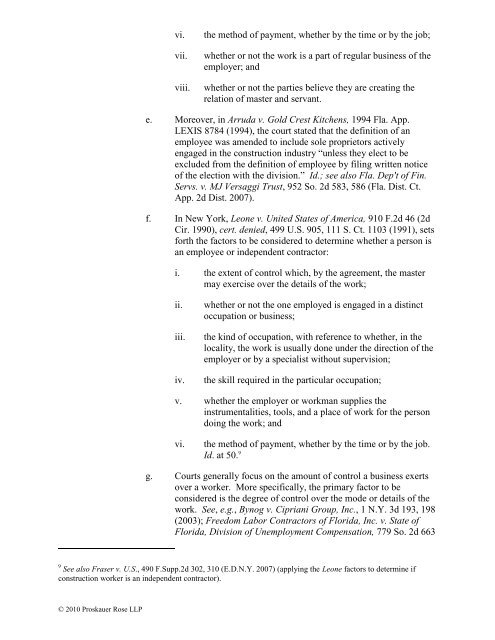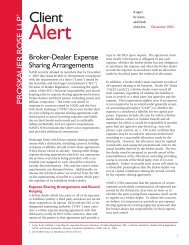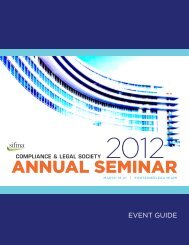Misclassification of Workers - Proskauer Rose LLP
Misclassification of Workers - Proskauer Rose LLP
Misclassification of Workers - Proskauer Rose LLP
Create successful ePaper yourself
Turn your PDF publications into a flip-book with our unique Google optimized e-Paper software.
© 2010 <strong>Proskauer</strong> <strong>Rose</strong> <strong>LLP</strong><br />
vi. the method <strong>of</strong> payment, whether by the time or by the job;<br />
vii. whether or not the work is a part <strong>of</strong> regular business <strong>of</strong> the<br />
employer; and<br />
viii. whether or not the parties believe they are creating the<br />
relation <strong>of</strong> master and servant.<br />
e. Moreover, in Arruda v. Gold Crest Kitchens, 1994 Fla. App.<br />
LEXIS 8784 (1994), the court stated that the definition <strong>of</strong> an<br />
employee was amended to include sole proprietors actively<br />
engaged in the construction industry “unless they elect to be<br />
excluded from the definition <strong>of</strong> employee by filing written notice<br />
<strong>of</strong> the election with the division.” Id.; see also Fla. Dep't <strong>of</strong> Fin.<br />
Servs. v. MJ Versaggi Trust, 952 So. 2d 583, 586 (Fla. Dist. Ct.<br />
App. 2d Dist. 2007).<br />
f. In New York, Leone v. United States <strong>of</strong> America, 910 F.2d 46 (2d<br />
Cir. 1990), cert. denied, 499 U.S. 905, 111 S. Ct. 1103 (1991), sets<br />
forth the factors to be considered to determine whether a person is<br />
an employee or independent contractor:<br />
i. the extent <strong>of</strong> control which, by the agreement, the master<br />
may exercise over the details <strong>of</strong> the work;<br />
ii. whether or not the one employed is engaged in a distinct<br />
occupation or business;<br />
iii. the kind <strong>of</strong> occupation, with reference to whether, in the<br />
locality, the work is usually done under the direction <strong>of</strong> the<br />
employer or by a specialist without supervision;<br />
iv. the skill required in the particular occupation;<br />
v. whether the employer or workman supplies the<br />
instrumentalities, tools, and a place <strong>of</strong> work for the person<br />
doing the work; and<br />
vi. the method <strong>of</strong> payment, whether by the time or by the job.<br />
Id. at 50. 9<br />
g. Courts generally focus on the amount <strong>of</strong> control a business exerts<br />
over a worker. More specifically, the primary factor to be<br />
considered is the degree <strong>of</strong> control over the mode or details <strong>of</strong> the<br />
work. See, e.g., Bynog v. Cipriani Group, Inc., 1 N.Y. 3d 193, 198<br />
(2003); Freedom Labor Contractors <strong>of</strong> Florida, Inc. v. State <strong>of</strong><br />
Florida, Division <strong>of</strong> Unemployment Compensation, 779 So. 2d 663<br />
9 See also Fraser v. U.S., 490 F.Supp.2d 302, 310 (E.D.N.Y. 2007) (applying the Leone factors to determine if<br />
construction worker is an independent contractor).




